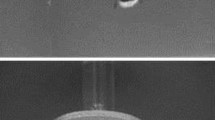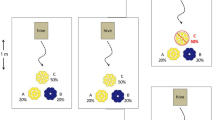Abstract
Flower visitors learn to avoid food-deceptive plants and to prefer rewarding ones by associating floral cues to rewards. As co-occurring plant species have different phenologies, cue-reward associations vary over time. It is not known how these variations affect flower visitors’ foraging costs and learning. We trained bumblebees of two colonies to forage in a community of deceptive and rewarding artificial inflorescences whose flower colours were either similar or dissimilar. We then modified the community composition by turning the rewarding inflorescences into unrewarding and adding rewarding inflorescences of a novel flower colour. In the short term, bees trained to similar rather than dissimilar inflorescences experienced higher costs of foraging (decreased foraging speed and accuracy) in the novel community. The colonies differed in their speed-accuracy trade-off. In the longer term, bees adapted their foraging behaviour to the novel community composition by increasingly visiting the novel rewarding inflorescences.



Similar content being viewed by others
References
Briscoe AD, Chittka L (2001) The evolution of colour vision in insects. Annu Rev Entomol 46:471–510. doi:10.1146/annurev.ento.46.1.471
Chittka L (1992) The colour hexagon: a chromaticity diagram based on photoreceptor excitations as a generalized representation of colour opponency. J Comp Physiol [A] 170:533–543
Chittka L, Thomson JD, Waser NM (1999) Flower constancy, insect psychology, and plant evolution. Naturwissenschaften 86:361–377. doi:10.1007/s001140050636
Chittka L, Spaethe J, Schmidt A, Hickelsberger A (2001) Adaptation, constraint, and chance in the evolution of flower colour and pollinator colour vision. In: Chittka L, Thomson JD (eds) Cognitive ecology of pollination. Cambridge University Press, Cambridge, pp 106–126
Chittka L, Dyer AG, Bock F, Dornhaus A (2003) Bees trade off foraging speed for accuracy. Nature 424:388. doi:10.1038/424388a
Chittka L, Ings TC, Raine NE (2004) Chance and adaptation in the evolution of island bumblebee behaviour. Popul Ecol 46:243–251. doi:10.1007/s10144-004-0180-1
Comba L, Corbet SA, Hunt L, Warren B (1999) Flowers, nectar and insect visits: evaluating British plant species for pollinator-friendly gardens. Ann Bot (Lond) 83:369–383. doi:10.1006/anbo.1998.0835
Corbet SA, Bee J, Dasmahapatra K, Gale S, Gorringe E, La Ferla B, Moorhouse T, Trevail A, Van Bergen Y, Vorontsova M (2001) Native or exotic? Double or single? Evaluating plants for pollinator-friendly gardens. Ann Bot (Lond) 87:219–232. doi:10.1006/anbo.2000.1322
Delforge P (2005) Guide des orchidées d’Europe, d’Afrique du nord et du Proche-Orient. Delachaux et Niestlé, Paris
Dukas R, Real LA (1993) Learning constraints and floral choice behaviour in bumble bees. Anim Behav 46:637–644. doi:10.1006/anbe.1993.1240
Dyer AG, Chittka L (2004a) Biological significance of distinguishing between similar colours in spectrally variable illumination: bumblebees (Bombus terrestris) as a case study. J Comp Physiol [A] 190:105–114. doi:10.1007/s00359-003-0475-2
Dyer AG, Chittka L (2004b) Bumblebees (Bombus terrestris) sacrifice foraging speed to solve difficult colour discrimination tasks. J Comp Physiol [A] 190:759–763
Dyer AG, Chittka L (2004c) Fine colour discrimination requires differential conditioning in bumblebees. Naturwissenschaften 91:224–227. doi:10.1007/s00114-004-0508-x
Elzinga JA, Atlan A, Biere A, Gigord LDB, Weis A, Bernasconi G (2007) Time after time: flowering phenology and biotic interactions. Trends Ecol Evol 22:432–439. doi:10.1016/j.tree.2007.05.006
Gigord LDB, Macnair MR, Stritesky M, Smithson A (2002) Experimental evidence for floral mimicry in a rewardless orchid. Proc R Soc Lond B Biol Sci 269:1389–1395. doi:10.1098/rspb.2002.2018
Gottlieb D, Keasar T, Shmida A, Motro U (2005) Possible foraging benefits of bimodal daily activity in Proxylocopa olivieri (Lepeletier) (Hymenoptera: Anthophoridae). Environ Entomol 34:417–424
Gumbert A (2000) Colour choices by bumble bees (Bombus terrestris): innate preferences and generalization after learning. Behav Ecol Sociobiol 48:36–43. doi:10.1007/s002650000213
Gumbert A, Kunze L (2001) Colour similarity to rewarding model plants affects pollination in a food deceptive orchid, Orchis boryi. Biol J Linn Soc Lond 72:419–433. doi:10.1111/j.1095-8312.2001.tb01328.x
Gumbert A, Kunze L, Chittka L (1999) Floral colour diversity in plant communities, bee colour space and a null model. Proc R Soc Lond B Biol Sci 266:1711–1716. doi:10.1098/rspb.1999.0836
Heinrich B (1976) Resource partitioning among some eusocial insects: bumblebees. Ecology 57:874–889. doi:10.2307/1941054
Internicola AI, Page P, Bernasconi G, Gigord LDB (2007) Competition for pollinator visitation between deceptive and rewarding artificial inflorescences: an experimental test of the effects of floral colour similarity and spatial mingling. Funct Ecol 21:864–872. doi:10.1111/j.1365-2435.2007.01303.x
Johnson SD, Peter CI, Nilsson LA, Ågren J (2003) Pollination success in a deceptive orchid is enhanced by co-occurring rewarding magnet plants. Ecology 84:2919–2927. doi:10.1890/02-0471
Kearns CA, Inouye DW (1997) Pollinators, flowering plants, and conservation biology. Bioscience 47:297–307. doi:10.2307/1313191
Keasar T, Motro U, Shur U, Shmida A (1996) Overnight memory retention of foraging skills by bumblebees is imperfect. Anim Behav 52:95–104. doi:10.1006/anbe.1996.0155
Little RJ (1983) A review of floral food deception mimicries with comments on floral mutualism. In: Jones CE, Little RJ (eds) Handbook of experimental pollination biology. Van Nostrand Reinhold, New York, pp 294–309
Lynn SK, Cnaani J, Papaj DR (2005) Peak shift discrimination learning as a mechanism of signal evolution. Evolution Int J Org Evolution 59:1300–1305
Manly BFJ (1997) Randomization bootstrap and Monte Carlo methods in biology. Chapman and Hall, London
Ollason JG, Ren N (2002) Taking the rough with the smooth: foraging for particulate food in continuous time. Theor Popul Biol 62:313–327. doi:10.1016/S0040-5809(02)00003-5
Pellegrino G, Bellusci F, Musacchio A (in press) Evidences for double floral mimicry and magnet species effect: the case of dimorphic, deceptive orchid Dactylorhiza sambucina and dimorphic, rewarding co-flowering Viola aethnensis. Preslia
R development Core Team (2005) R: a language and environment for statistical computing. R Foundation for Statistical Computing, Vienna, Austria. ISBN 3-900051-00-3. URL: http://www.R-project.org
Raine NE, Chittka L (2007a) Nectar production rates of 75 bumblebee-visited flower species in a German Flora (Hymenoptera: Apidae: Bombus terrestris). Entomol Gen 30:191–192
Raine NE, Chittka L (2007b) The adaptive significance of sensory bias in a foraging context: floral colour preferences in the bumblebee Bombus terrestris. PLoS ONE 2:e556. doi:10.1371/journal.pone.0000556
Raine NE, Chittka L (2008) The correlation of learning speed and natural foraging success in bumble-bees. Proc R Soc Lond B Biol Sci 275:803–808. doi:10.1098/rspb.2007.1652
Raine NE, Ings TC, Ramos-Rodríguez O, Chittka L (2006a) Intercolony variation in learning performance of a wild British bumblebee population (Hymenoptera: Apidae: Bombus terrestris audax). Entomol Gen 28:241–256
Raine NE, Ings TC, Dornhaus A, Saleh N, Chittka L (2006b) Adaptation, genetic drift, pleiotropy, and history in the evolution of bee foraging behaviour. Adv Stud Behav 36:305–354. doi:10.1016/S0065-3454(06)36007-X
Salzmann CC, Schiestl FP (2007) Odour and colour polymorphism in the food-deceptive orchid Dactylorhiza romana. Plant Syst Evol 267:37–45. doi:10.1007/s00606-007-0560-z
Smithson A, Macnair MR (1997) Negative frequency-dependent selection by pollinators on artificial flowers without rewards. Evolution Int J Org Evolution 51:715–723. doi:10.2307/2411148
Sparks TH, Jeffree EP, Jeffree CE (2000) An examination of the relationship between flowering times and temperature at the national scale using long-term phenological records from UK. Int J Biometeorol 44:82–87. doi:10.1007/s004840000049
Trevelyan R (1995) The feeding ecology of Stephen’s lorry and nectar availability in its food plants. Biol J Linn Soc Lond 56:185–197. doi:10.1111/j.1095-8312.1995.tb01084.x
Wolf TJ, Schmid-Hempel P (1989) Extra loads and foraging life span in honeybee workers. J Anim Ecol 58:943–954. doi:10.2307/5134
Acknowledgements
We thank C. Benetollo, P. Busso, H. Gabioud, C. Ohayon, A. Pasche and A. Reber for practical help. We are grateful to M. Giurfa for providing the spectral sensitivity functions of bumblebees, to J. Goudet for his valuable assistance with statistical analyses and to L. Chittka and J. Ollerton for helpful comments. This study was supported by the Roche Research Foundation (grant no. 22-2004 to GB and LG), the Swiss National Science Foundation (grants no. 3100A0-100754/1 to LG and PPOOA-102944/1 to GB), the Société Académique Vaudoise (Switzerland) and the Bureau de l’Egalité des Chances (University of Lausanne, Switzerland).
Author information
Authors and Affiliations
Corresponding author
Additional information
Rights and permissions
About this article
Cite this article
Internicola, A.I., Page, P.A., Bernasconi, G. et al. Carry-over effects of bumblebee associative learning in changing plant communities leads to increased costs of foraging. Arthropod-Plant Interactions 3, 17–26 (2009). https://doi.org/10.1007/s11829-008-9051-6
Received:
Accepted:
Published:
Issue Date:
DOI: https://doi.org/10.1007/s11829-008-9051-6




